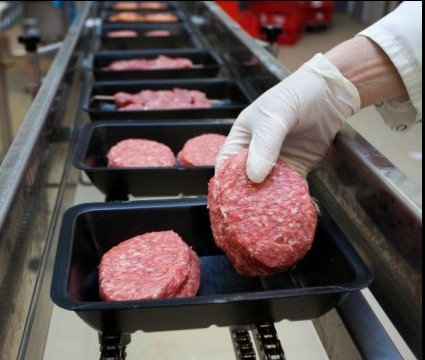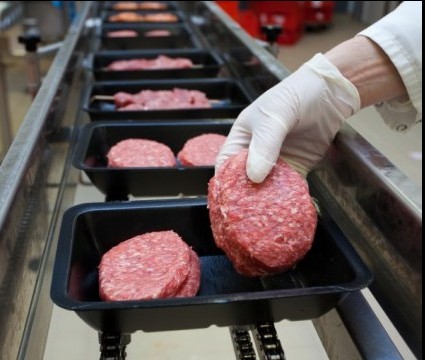 Tainted burger, coming soon to a plate near you? In Meat Wagon, we round up the latest outrages from the meat and livestock industries.
Tainted burger, coming soon to a plate near you? In Meat Wagon, we round up the latest outrages from the meat and livestock industries.
———————————
(This is the first Meat Wagon column in months. No, the meat industry hasn’t suddenly become socially and ecologically responsible. I’ve just been distracted by other topics.)
Where’s the tainted beef?
If you regularly eat fast-food burgers or unlabeled supermarket beef, you’ve almost certainly consumed a JBS product in the past month. That’s because Brazil-based JBS is the globe’s largest beef producer–and the third-largest U.S. beef packer. And what a month it’s been for this emerging beef behemoth.
Here in the U.S., JBS has dramatically expanded a “voluntary” recall of beef “that may be contaminated with E. coli O157:H,” the USDA reports. (Hat tip, Obama Foodorama.) USDA rates the recall Type 1, meaning the product presents a “high” health risk. The recall originally involved 41,000 pounds; now the company is trying to call in 421,000 pounds. Ouch.
(It’s Meat Wagon tradition to convert such abstract-seeming figures into what we like to call Quarter Pounder Equivalents. According to our proprietary computer models, JBS has officially released enough suspect beef for McDonald’s to crank out approximately 1.7 million Quarter Pounders.)
Meanwhile, down in Brazil, JBS is being investigated by the Brazilian government for “bribing of public officials, racketeering, corruption, fraud and collusion,” Reuters reports. Not long ago, Greenpece called out the company for knowingly buying cows raised on illegally cleared rain-forest land. Charming company, huh?
As for the U.S. recall, those 421,000 pound were “distributed nationally and internationally,” the USDA reports, without adding which states and nations received it. Let’s all bow our heads for a moment and ponder what it means that a single beef-processing plant could produce nearly half a million pounds of beef in a day–and send it out to points unknown across the globe. Like a butterfly’s wings, a little bullshit in a massive slaughterhouse can have tremendous global impact (pun, um… intended!).
And get this: the dodgy beef got processed way back on April 21–meaning it has been circulating in the food system for three months. Already, 18 people in “multiple [but unspecified] states” are known to have been infected, the USDA reports. Obama Foodorama reports that the CDC reckons that for every confirmed E. coli case in an outbreak like this one, 35-50 people more actually comes down with it: “That’s between 630 and 900 people already ill.”
And the number of infected will almost surely grow. Very little of the suspect beef will likely ever actually come back; most of it will be consumed by unwitting consumers. As Obama Foodoramaputs it:
Recalls are VOLUNTARY. There is no requirement legally that the products be tracked down by the processor and yanked from store shelves, out of restaurant freezers, out of community and church group food lockers. There’s no requirement that grocers or chefs not use contaminated products.
Now, in the above-linked press release, the USDA calls JBS a “Colorado firm.” That’s wrong. The plant where the outbreak originated is located in Colorado, but, as noted above. JBS is a globe-spanning beef producer based in Brazil, and identified by Reuters as the “world’s biggest beef processor.”
After a buying spree last year–partially blocked by the U.S. Justice Department on antitrust concerns –JBS is one of the the three largest U.S. beef packers, along with Tyson and Cargil. Together, the three giants slaughter nearly four in five beef cows raised in the U.S., giving them tremendous power over their farmer suppliers.
In a recent report, Food and Water Watch teases out the devastating effect of this intense consolidation on small- and medium-scale farmers–who raise precisely the kind of pasture-raised, relatively sustainable meat consumers are increasingly demanding. The FWW report is worth reading in its entirety; for our food-safety purposes, let’s look at a discussion of how the USDA tests slaughterhouses for E. coli contamination. According to FWW:
• The agency creates incentives for plants to use interventions (e.g. chemical sprays or hot water rinses).
• The agency avoids collecting data or performing tests that would show if these technologies are not being used effectively at the largest beef slaughter plants.
• The agency avoids enforcement of regulations at these large plants when it learns of unsafe production practices and contamination coming from these plants.
In other words, the USDA’s inspection program is much more geared to protecting the profitability of the meat giants than it is to protecting the public health.
Gigantic meat companies probably couldn’t exist without a toothless food-safety regime. Take the current recall. JBS has already sold that 421,000 pounds of beef. It will reimburse any meat that actually comes back, but the rest of it is gone–profit booked. Imagine if a government inspector had shown up on April 21, the day the suspect meat was processed, and taken a swab. The company would have had to stop operations–and likely have had to destroy the day’s output. Imagine the losses.
Got PBDEs?
PBDEs–short for polybrominated diphenyl ethers–are intensely nasty, and shockingly ubiquitous. They’re a flame retardant that manufacturers put in mattresses, rugs, electronic gadgets, and even clothes. According to the Environmental Working Group, they’re associated with a host of human maladies, including” thyroid hormone disruption, permanent learning and memory impairment, behavioral changes, hearing deficits, delayed puberty onset, decreased sperm count, fetal malformations and, possibly, cancer.”
And, they appear to be even more harmful for young children and fetuses than adults. Animal research shows that “exposure to brominated fire retardants in-utero or during infancy leads to more significant harm than exposure during adulthood, and at much lower levels,” EWG reports.
So, what does this have to do with industrial meat? Well…. meat eaters have show significantly higher concentrations of PBDEs in their bodies than do vegetarians, according to a study (PDF) just published in the peer-reviewed Environmental Health Perspectives by three Boston University public-health scholars.
They conclude: “Intake of contaminated poultry and red meat contribute significantly to PBDE body burdens in the United States.” How our meat becomes contaminated, the authors don’t speculate. Might it be because of the vast scale of our meat production–and its intensley industrial nature?




